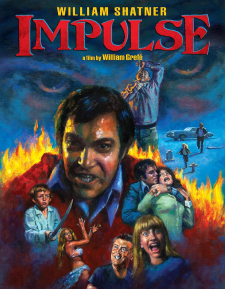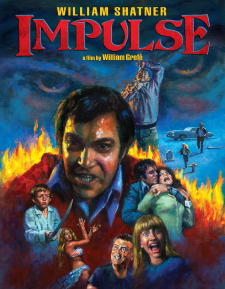Impulse (Blu-ray Review)

Director
William GreféRelease Date(s)
1974 (March 12, 2024)Studio(s)
Conqueror Films/Camelot Films (Grindhouse Releasing)- Film/Program Grade: C+
- Video Grade: B
- Audio Grade: B
- Extras Grade: A
Review
Impulse (1974), a crime thriller with slight horror elements starring William Shatner, unjustly falls into that “so-bad-it’s-good” category, a picture to be laughed at for Shatner’s supposedly hammy performance, its low-budget ineptitude, and outdated, even alarming ‘70s fashions.
In fact, this low-budget ($250,000) exploitation film filmed in Florida is well above average for films of this type and budget level. Shatner’s performance is generally very good, and the film’s screenplay has an air of verisimilitude, it’s genuinely creepy at times, despite a couple of unintentionally funny moments, variable supporting performances, and a cheapness it can’t entirely hide. Reportedly it made something like $4 million at the box-office making it, for what it was, a substantial hit.
Grindhouse Releasing’s two-disc Blu-ray is packed to the gills with extra features, including a more than one-hour interview with Shatner and two additional features also directed by William Grefé: The Devil’s Sisters (1966) and The Godmothers (1973), though both of those are full-frame and appear derived from poor standard-def masters. Those films are also terrible, almost unwatchable.
Impulse opens near the end of World War II, when as a boy Matt Stone kills his mother’s abusive, serviceman boyfriend with a samurai sword. Though this prologue is filmed in black-and-white, the apparently real Florida living room used for filming is decorated with typical 1970s furniture and knickknacks and hardly convincing.
As an adult Matt (Shatner) has become a professional conman who charms young women into giving Matt their life savings, sometimes killing them when they discover they’re being duped. After strangling one such woman, Matt next sets his sights on recently widowed Ann Moy (Jennifer Bishop), who seems anything but rich, though her best friend, the older Julia (Ruth Roman), certainly is. Ann’s daughter, Tina (Kim Nicholas), is suspicious of Matt’s motives from the start, on top of not wanting anyone to replace her dead father so soon after his death.
Complicating matters is the arrival of Matt’s former cellmate, wrestler “Karate Pete” (Harold “Oddjob” Sakata), who wants to muscle in on a piece of the action. Tina, who always seems to be in the wrong place at the wrong time, not only peers into a motel window to catch her mother and Matt having sex, she also witnesses Matt’s brutal murder of Pete at a car wash late one night.
After Star Trek, Shatner entered a decade-long stretch of taking virtually any job to support his family. He did guest shots on popular TV shows, but also appeared in low-budget movies, television commercials, industrial films, made personal appearances at county fairs, and roamed the country doing dinner theater living out of a truck-bed camper. Reportedly Grefé ran into Shatner at an airport and offered him the film on the spot.
A Canadian and contemporary of Christopher Plummer, Shatner began on the stage but soon became, along with Cliff Robertson, Richard Kiley, Jack Klugman and a few others one of the most sought-after actors of early ’60s American television, often playing handsome young men undergoing some disturbing psychological unraveling over the course of episodes of Naked City, Thriller, The Defenders, Twilight Zone and many others. (You want dreamy-eyed philosophers? You hired Robertson. Straight-laced everymen? Kiley. Three-time urban losers? Klugman.)
But Shatner was too good an actor to be pigeonholed. He gave a superb performance as a racist agitator in Roger Corman’s The Intruder—a film that really needs a Criterion-level release—and, of course, was perfect as the swaggering, dedicated Capt. James T. Kirk on Star Trek. During the 1970s Shatner was like Bela Lugosi in later years in the sense that, no matter how good or bad the project he was hired for might be, Shatner always delivered a fully-committed performance. Like Lugosi, some audiences misconstrue this as hamming it up, but nearly always Shatner delivers exactly the performance required by each script for each character. In Impulse he’s mostly on the money—effortlessly charming women some of the time, set off into something like clinical panic attacks when challenged by Tina and others.
The big problem with Impulse isn’t Shatner but rather the Tina character, both in the writing and performance of that character. She starts out as a Patty McCormack Bad Seed-type: spoiled, manipulative, and bratty, an overly pampered girl who lies so much no one believes her when she tells others that Matt is a dangerous killer. Kim Nicholas isn’t a terrible child performer but really isn’t up for such a challenging part, either.
Ruth Roman is good as the wealthy, would-be matchmaker for Ann and Matt, but Harold Sakata—Did Grefé ambush him at the airport, too?—is miscast. As Oddjob in Goldfinger, Sakata was an amusing, intimidating Bond villain, but that part was mute. In Impulse, Sakata’s few scenes are dialogue-heavy, and he’s no more believable than Tor Johnson garrulous police inspector in Plan 9 from Outer Space. Like Tor Johnson, Sakata was more a living prop than an actor.
Grindhouse Releasing presents Impulse in its original, 1.85:1 widescreen aspect ratio. A disclaimer states the original camera negative has been lost, and that their 4K scan sources a 35mm release print. This doesn’t bode well, but in fact the presentation mostly looks fine, with some minor imperfections probably inherent to the original camera work and printing. The DTS-HD Master Audio (2.0 mono) is fine, optional English subtitles are provided, and the two-disc set is Region “A” encoded.
Supplements abound. The features The Devil’s Sisters, in black-and-white, and The Godmothers, in blotchy color, are both full-frame and derived from standard-def sources, probably masters 30 or more years old. The older film is, generally, less terrible than the later, color film, but each is impressively awful, The Godmothers a particularly dismal, profoundly unfunny comedy with Mickey Rooney and Jerry Lester. Extras on Disc 1 also include: a commentary track on Impulse by the director; The Making of Impulse (14 minutes); Shatner Saves Sakata (1 ½ minutes); a 40th Anniversary Screening at the Tampa Theater with the director; and two trailers, also in high-def. The Devil’s Sisters also features a commentary by director Grefé, Devil’s Sisters Revisited (9 minutes), Bill Grefé and The Devil’s Sisters (1 ½ minutes), a radio spot, and image gallery. For The Godmothers, there’s a four-minute intro by Grefé.
Disc 2 contains the most enjoyable extra feature, a 64-minute appearance by Shatner at the Aero Theater in Los Angeles following a marathon screening of Impulse, Kingdom of the Spiders, and The Devil’s Rain. Shatner doesn’t even like to watch his good movies, and shows up to a Q&A without ever having seen Impulse or the other films. Nevertheless, this highly entertaining interview has him telling a few anecdotes about each film, his appreciation of low-budget filmmakers, thoughtful, even moving moments about his recent trip into space, and other topics. Also included is a 26-minute appreciation of Shatner and 5-minute follow-up by C. Courtney Joiner; a 33-minute interview with Impulse associate producer Doug Hobart; a 78-minute (!) interview with Grefé; another 25 minutes with Grefé called Bill’s Miami Stories; and, if one is not thoroughly sick of him by this point, another 43 minutes of Bill’s Sea Stories.
But wait—there’s more. Also on Disc 2 is yet another Grefé interview, this time from 2011 running 12 minutes; a two-minute local news clip about Grefé’s involvement with Live and Let Die; a 9-minute overview of Grefé; an 18-minute discussion about the Florida film biz with Grefé; THREE feature-length filmmaking seminars with Grefé, totaling upwards of four hours; three industrial films featuring Shatner; four short films; and scads of stills, video box art, etc., in an extensive image gallery. Whew.
While I doubt even die-hard fans of Williams Grefé or Shatner will want to spend the hours and hours poring through all of these extra features, Impulse is not a terrible film at all, really, a modest artistic and considerable commercial success worth seeing. Recommended.
- Stuart Galbraith IV

